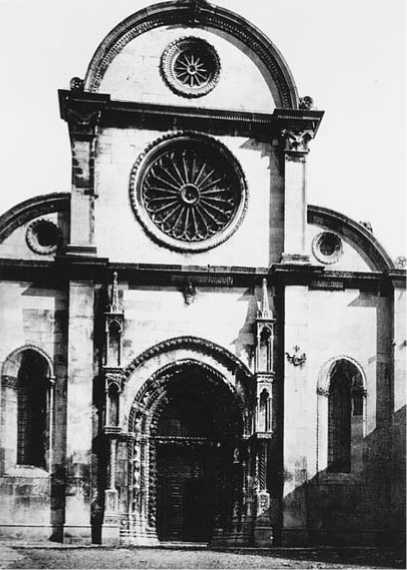The Cumans, or Polovtski, consisted of the western tribes of Turkics in the tribal confederation of the nomadic Kipchaks, living in western Asia and eastern Europe from the Aral Sea to the Black Sea by the 11th century C. E. (The name Cumans is used both as a synonym and as a designation of a subgroup of Kipchaks.) The Cumans expanded into central Europe by the 12th century. After Mongols invaded Europe in the 13th century some Cumans migrated into Hungary Byzantines called them Cumans; Slavs called them Polovtsi, and Magyars referred to them as Kuns. Cuman means “pale” or “sallow” in varying languages.
Origins
The ancestors of the Cumans, as with other Kipchaks, are thought to have lived in western

This late-19th-century photograph shows the facade of the cathedral at 5>ibenik, Croatia, formerly Dalmatia. (Library of Congress, Prints and Photographs Division [LC-USZ62-109393]) siberia by the ninth century and to have migrated into Europe by the 11th century.
LANGUAGE
The Cumans spoke the now-extinct Cuman (Kuman) dialect of the Northwestern (Kipchak; Ogur) branch of the Turkic language. A number of dictionaries exist from the Middle Ages, including the late-13th-century Codex Cumani-cus, with words presented in Kipchak, Latin, and Persian.
History
The Cumans carried out raids in present-day Romania by the late 11th century, defeating the Pechenegs, also Turkic speaking, in 1064 and absorbing survivors into their tribes. in 1090-91 some Cumans were allied with the Byzantines against the Pechenegs. By the 12th century the Cumans controlled territory in present-day Moldova and the regions of Transylvania and Walachia in present-day Romania, whence they carried out raids south of the Danube River. In the first half of the 13th century Mongols invaded Cuman lands. Some Cumans sought asylum among the Rus in present-day Ukraine, others among the Bulgars in present-day Bulgaria, and among the Magyars in present-day Hungary. Others
CUMANS
Location:
Eastern and central Europe
Time period:
11th to 13th century C. E.
Ancestry:
Turkic
Language:
Cuman (Turkic)
Cumans time line
C. E.
11th century Kipchaks settle lands north of Black Sea; western tribes become known as Cumans.
12th century Cumans settle in Romania.
1220s Mongols arrive on Cuman territory.
1245 Cumans settle permanently in Hungary.
Became subjects of the Mongols in what became known as the Kipchak khanate.
In 1221-25 the Teutonic Knights, a military and religious order that had been active in the Christian Crusades to the Near East, campaigned on behalf of King Andrew II of Hungary against the Cumans. In 1227 the Cuman prince Barc and 15,000 of his people were baptized as Christians. King Bela IV of Hungary assumed the title “king of Cumania,” and two years later granted asylum to the Cuman prince Kuthen and his followers, who had earlier tried to organize a Slavic resistance to the Mongols. But he was murdered as a potential threat to Magyar interests. The Cumans left Hungary during the Mongol invasion of 1240-41, but Bela resettled them there in 1245. The wife of Stephen V, Bela’s son, was a Cuman princess. Their son Laszlo (Ladislas) was known as the Cuman and, during his reign in 1272-90 the Cumans played an important role in Hungarian affairs.
The Cumans, known for their fighting skills, served as mercenaries for a number of armies in the region, including the Byzantines and the crusaders out of western Europe.
CULTURE (see Turkics)
The experience of ranging through the vast and empty steppe lands seems to have affected the cultures of all nomadic steppe peoples along similar lines. The Cumans were no exception. The Byzantines, in grouping the various steppe peoples who attacked them, including the Cumans, together as the Scythians, a name given by the Greek historian Herodotus to a people of his own time (fifth century B. C.E.), may have been guilty of oversimplification in equating diverse cultures from different places and times. Yet there is more than a little truth to this view. The looseness and freedom of steppe culture, the constant travel over long distances to find decent grazing in a harsh climate, the propensity for raiding, the autonomy of individuals (though males only), the formation of tribes and hordes, and the lack of codified law were all common characteristics of the Scythians, Sarmatians, Huns, Avars, Cumans, and other Turkics.
The Cumans, as did other nomadic steppe peoples, swept into Europe as conquerors and controlled territory for a time. Although they were not the founders of a permanent state, they played an important role for centuries in relation to other peoples.
Further Reading
Andras Paloczi Horvath. Pechenegs, Cumans, lasians: Steppe Peoples in Medieval Hungary (Budapest: Corvina, 1989).
Istvan Vasary. Cumans and Tatars: Oriental Military in the Pre-Ottoman Balkans, 1185-1361 (Cambridge: Cambridge University Press, 2005).
Curonians (Cours; Courans; Courones; Cori; Curi; Curlandrs; Kurs; Kurons; Kursa; Kursi; Kurshi; Kurzemians; Kurlanders; Kershes)
The Curonians, a tribe of Balts, lived in the region known as Courland, situated along the Baltic Sea and the southwest shore of the Gulf of Riga in present-day western Latvia. They had extensive contacts with Vikings across the Baltic Sea in Scandinavia at least by the ninth century. Along with the Letts, Selonians, Semigallians, and assimilated Finnic-speaking peoples (such as from among the Esths, Livs, and Votes), they are among those peoples considered ancestral to contemporary Latvians (see Latvians: nationality).
ORIGINS
By about 2000-1500 B. C.E. pre-Baltic peoples, probably indo-European-speaking, inhabited the region; the Curonians and other tribes would emerge in the region by the ninth century C. E. The name of the Curonians occurs in historical sources earlier—as the Latin Cori in 853 C. E.—than the names of the other tribes in the region. Kur in Latvian means “mound” or “hill” and is possibly related etymologically.
LANGUAGE
Some scholars consider the now-extinct Curonian to have been a transitional language between Eastern and Western Baltic. The Curonian language still existed at the end of the 16 th century, but Curonians already used it less often than the Latvian language.
HISTORY
Curonians and Vikings
The Curonians traded with the peoples of Scandinavia directly across the Baltic Sea, but trading parties were frequently attacked and robbed on both sides. In about the ninth century the Vikings of present-day Sweden and Denmark invaded Courland. A reason for the hostilities was retribution against the successful attacks on Swedish and Danish towns; another reason was the struggle for control of the river mouths and usable ports from which traders could penetrate the continent and trade with the Mediterranean region. The Balts would continue to offer fierce opposition to the Vikings for centuries.
In 840, according to the Danish historian Saxo Grammaticus (who wrote in the 13th century), the Viking leader Ragnar Lodbrok organized a raid on the Curonians and Sambians, a subgroup of Borussians. In 853 the Vikings again attacked the Curonians and lost to a united army of five Curonian tribes. The Vikings attacked again, capturing Seeburg (modern Grobina in Latvia) and Auole (near modern Skuodas in Lithuania).
Conflicts continued over the centuries. In 1161 the Danes captured Palanga Castle in Courland. In 1170 Curonians and Esths attacked Oland Island in Sweden.
Curonians and Crusaders
In 1202 the German prelate Albert von Buxhoevden founded the military and religious order Brothers of the Sword, uniting and controlling the various military factions. In 1210 Curonian ships were able to defeat German ships in Irbe channel and kill more than 30 crusaders. They then attacked Riga, but the city’s defenses held out.
Over the next years the order subdued the various Baltic and Finnic peoples in the region. In 1230 the Curonian king Lamikis, pressured by the Danes, Lithuanians, and Poles, and in order to avoid rule by Brothers of the Sword, agreed to become a vassal of the pope. The Brothers of the Sword (who merged with the Teutonic Knights) refused to honor this arrangement, and by 1269 had subjugated the Curonians, making Courland their domain. In 1561 the Teutonic Knights dissolved their order and combine Courland and Semigallia into the duchy of Courland, which became a Polish fief.
CULTURE (see also Balts)
Economy
Early Curonians were farmers and herders, who also gathered berries and mushrooms, kept bees, and hunted small game. Because the main trade road from the Scandinavian region to Byzantium passed through Courland, a rich trading culture developed. An important export was amber, found in large quantities on the coasts of the Baltic Sea.
Government and Society Curonians organized their territory in regions and built heavily fortified castles. Before the medieval period Curonians, as did most ancient Balts, had a relatively egalitarian society. Communal meetings would be held periodically, presided over by a council of elders. Medieval Curonians organized their territory in regions and built heavily fortified castles. They adopted the practice, widespread over northern Europe, of organizing their fighting men into military orders.
Music
Curonians performed daino, song cycles, believing that nature will reveal itself if the song is sung correctly and the dance rhythms evoke the right vibrations. A common practice among traditional tribal cultures, it was a means by which humans could interact with nature and thus ensure the well-being of the tribe.
Religion
The Curonians were known for their prophets, who supposedly could foretell the future, and peoples of other cultures traveled to them for consultation.
In 1075 the German historian Adam of Bremen described the Curonians as “the most cruel
Curonians time line
CURONIANS
Location:
East of Vistula River at Gulf of Riga
Time period:
Ninth century to 1561 C. E.
Ancestry:
Baltic
Language:
Baltic
C. E.
840 Viking leader Ragnar Lodbrok organizes raid on Curonians and Sembians.
853 Vikings invade Courland.
1161-70 Curonian and Viking conflict
1202 Military and religious order Brothers of the Sword is founded to Christianize Baltic lands.
1210 Curonians attack Riga.
1269 Brothers of the Sword defeat Curonians.
1561 Teutonic Knights dissolve their order and combine Courland and Semigallia into duchy of Courland, which becomes Polish fief.
CYCLADITES
Location:
Cyclades Islands of Greece
Time period:
C. 3300 to c. 2000 b. c.e.
Ancestry:
Unknown
Language:
Possibly Semitic
Tribe.” The Vikings, fierce warriors in their own right, had a prayer that asked protection from “fire, storm and the Curonians.”




 World History
World History









